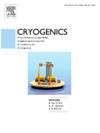Experimental study of initial frost surface coverage characteristics on cryogenic cold surfaces under natural convection
IF 2.1
3区 工程技术
Q3 PHYSICS, APPLIED
引用次数: 0
Abstract
Experimental investigations of frost formation initial stage on vertical cold plate surface under the conditions of natural convection reveal distinct growth patterns of initial frost crystals across temperatures ranging from −50 ℃ to −190 ℃. Frosting mechanism is significantly influenced by the cold plate temperature, which changes from the cold surface condensation/desublimation to the boundary layer condensation/desublimation as cold plate temperatures decrease. Correspondingly, frost crystal growth characteristics under different frost mechanisms are also different, which are first reflected in the frost formation initial stage. The effects of cold plate temperatures especially lower than −100 ℃ as well as the environmental parameters on the frost crystal coverage was focused. It has been discovered that frost crystal coverage increases as cold plate temperature drops from −50 ℃ to −100 ℃. Similarly, the rate of frost crystal coverage increases significantly first with air temperature and relative humidity, after that their influence weakens with higher air values. However, at lower temperatures from −100 ℃ to −170 ℃, frost crystal coverage decreases with further cooling, while air temperature and relative humidity exhibit negligible influence on early frost formation, with their effects weakening progressively at colder conditions. Changes in the frost formation mechanism are the primary reason for this phenomenon. This paper can enhance the comprehension of the frost formation initial stage and provide a reference for defrosting and frost suppression on cryogenic surfaces.
自然对流作用下低温冷面初始霜面覆盖特性的实验研究
自然对流条件下垂直冷板表面结霜初期的实验研究表明,在−50℃~−190℃温度范围内,初始结霜晶体的生长模式明显不同。结霜机制受冷板温度的显著影响,随着冷板温度的降低,结霜机制由冷表面凝结/去升华转变为边界层凝结/去升华。相应的,不同结霜机制下霜晶生长特征也不同,这首先体现在结霜初期。重点研究了冷板温度(特别是低于- 100℃)和环境参数对霜晶覆盖的影响。研究发现,当冷板温度从- 50℃降至- 100℃时,霜晶覆盖率增加。同样,霜晶覆盖率首先随着空气温度和相对湿度的增加而显著增加,然后随着空气值的增加而减弱。然而,在−100℃~−170℃较低的温度下,霜晶覆盖率随着降温而降低,而气温和相对湿度对早期霜形成的影响可以忽略不计,在较冷的条件下,其影响逐渐减弱。结霜机制的变化是造成这一现象的主要原因。本文可以加深对结霜初期的理解,为低温表面的除霜和抑霜提供参考。
本文章由计算机程序翻译,如有差异,请以英文原文为准。
求助全文
约1分钟内获得全文
求助全文
来源期刊

Cryogenics
物理-热力学
CiteScore
3.80
自引率
9.50%
发文量
0
审稿时长
2.1 months
期刊介绍:
Cryogenics is the world''s leading journal focusing on all aspects of cryoengineering and cryogenics. Papers published in Cryogenics cover a wide variety of subjects in low temperature engineering and research. Among the areas covered are:
- Applications of superconductivity: magnets, electronics, devices
- Superconductors and their properties
- Properties of materials: metals, alloys, composites, polymers, insulations
- New applications of cryogenic technology to processes, devices, machinery
- Refrigeration and liquefaction technology
- Thermodynamics
- Fluid properties and fluid mechanics
- Heat transfer
- Thermometry and measurement science
- Cryogenics in medicine
- Cryoelectronics
 求助内容:
求助内容: 应助结果提醒方式:
应助结果提醒方式:


